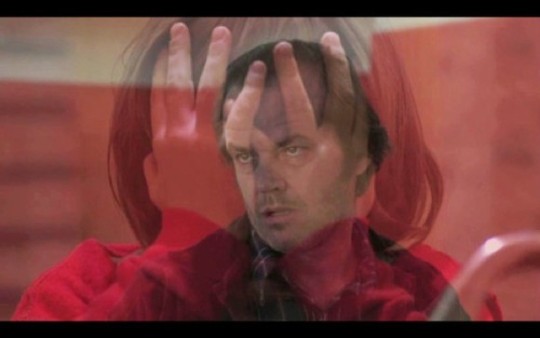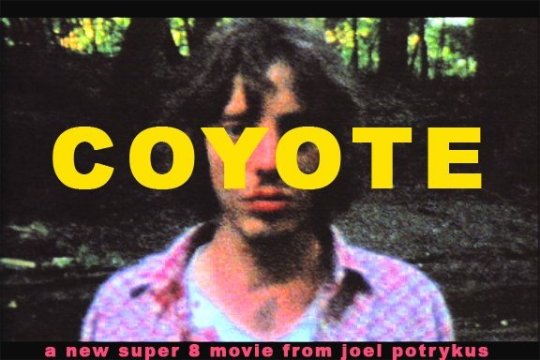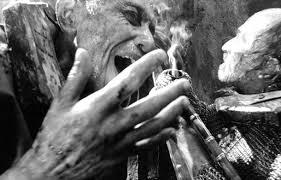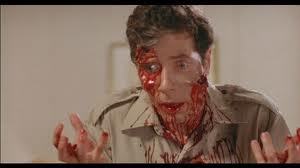Text
PURPLE-DRANK CINEMA: KUBRICK CHOPPED AND SCREWED

Rodney Ascher’s 2012 documentary ROOM 237 demands a common language. This language consists not of words, but of familiar images, familiar sounds, familiar faces, familiar voices. It demands that you’ve seen Stanley Kubrick’s THE SHINING-which, no doubt, you have. (Otherwise I’m not sure that we can be friends.) And because you’ve seen THE SHINING you know what it means when Jack Nicholson hacks his way through a locked bathroom door with a fire axe, and you know what REDRUM means (spoiler: It’s “goblin” backwards), and you know what it means when Jack stumbles through a frozen-wasteland of a hedge maze in search of his next victim. You know what it means when those two little girls show up in the hallway. You know the big wheel. You know the carpet. You know that Lloyd pours the stiffest drinks in town. Oh the things you know about THE SHINING.
(You probably don’t know what it means when that dude in the dog suit shows up, though. Don’t feel bad though, no one knows what that means.)
Maybe, as the discordant chorus of voices making up ROOM 237’s “cast” inform us, you only think that you know these things about THE SHINING. It turns out, funnily enough, that you don’t know anything about THE SHINING. Not because you’re an idiot (you’re probably pretty alright-don’t be so hard on yourself!). It’s because THE SHINING isn’t a movie about a haunted hotel, or an alcoholic father trying to get his life together, or a worried mother doing the best to protect her troubled son, or any of those other things that you thought were happening on the screen. THE SHINING, you see, is a film about how Stanley Kubrick faked the moon landing. Or, wait, maybe it’s about the United States’ sad history of subjugation and extermination of the Native American population. Or, wait, no-maybe it’s about the Holocaust? Or maybe it has something to do with a Minotaur.
Don’t worry: you don’t just have to take their word for it. They have proof. They all have proof. ROOM 237 is a jabbering howl of voices using the same damn words to tell you nine different stories. Kubrick’s THE SHINING is more than the Ur-text from which Ascher’s exclusively off-screen pundits (this film, too, has its ghosts) draw their feverish conclusions; Kubrick’s film (the images he staged and shot, the clothes his actors wore, the way they stood, or sat, or blinked) becomes the materfamilias from which ROOM 237 is birthed. The all-important proof, that alchemical ingredient that transforms mouth-spittle rant into serious theory, is right there on the screen.
That is, if you have the gumption to actually see it. The paranoid joy of ROOM 237 comes from its gleeful dismantling of a certain implicit trust between directors and their audiences. The director promises to show us a series of images (maybe these images have accompanying sounds, maybe they don’t), and each one of these images tells us something. Here is a man. Here is a house. Here is a gun. Here is a woman confessing her love to a man who will never love her. Here is a radioactive lizard monster taller than mountains, come to destroy us all. And so on. Even when these images are obtuse or challenging, when they make us squint at the screen, when they overwhelm us with color, or motion, or size, there still exists the understanding that we are on equal footing with the filmmaker. The director is pouring her time, her soul, and her intellect on the screen preciously so we might come to know something deeply; something which, until the moment it plays for us in that darkened room, existed only for the filmmaker.
“Bullshit,” says ROOM 237. The film’s theorists know that what we think of as THE SHINING is a celluloid Trojan Horse. It is only when we ruthlessly torture the words and sounds and lights of Kubrick’s SHINING that the actual film, the real object lurking beneath that supposed ghost story, confesses its darkest crimes: Sloooooooooooow a sequence down, play it back and forth, back and forth, back and forth like the Zapruder film, lay images on top of one another, play them backwards, speed them up, obsessively scan for infinitesimally small continuity errors from shot to shot-only then will the truth be revealed! Of course it’s about the moon landing! Of course it’s about genocide!
(Although that skiing poster still doesn’t look like a fucking Minotaur.)
Of course they can’t all be right. Even if by some amphetamine-fueled strike of enlightenment one of these theories managed to be true, it would necessarily mean that all the others were false. Truth (at least the kind of sweaty-palmed, fervent Truth put forward by our friendly paranoiacs) is cruel that way. These are people who’ve spent countless hours praying over this one film like Talmudic scholars, all because they think that they’ve unlocked some deeper, truer path. And they want us to join them in this new Eden, painstakingly created shot by shot. There is no small whiff of human desperation here. But it’s a charming desperation. You kind of want them all to be right, in the sense that you want all the little boys and girls on the pee-wee soccer team to leave the tournament with trophies. They’re trying, god damn it. Isn’t that worth something?
Put a gun to my head and I’d wager that none of ROOM 237’s theories are true. And so would you. ROOM 237 will only waste your time if you think that it might teach you “the truth” about THE SHINING. It’s not interested in this sort of truth. It’s interested in the kinds of people who might be interested in this sort of true, those brave few for whom THE SHINING (by which they mean the real SHINING) is found only in the radical dismemberment of said narrative. It is the cinephiles’ echo to that snottiest of French slogans of socialist fury: “Under the Paving-Stones: The Beach!” And under the SHINING…what, exactly? For them THE SHINING is a film of isolated, cryptic moments (which moments are to be isolated, and for what reasons, being particular to each theory). Everything else is just so many indistinguishable grains of sand on the beach.
0 notes
Text
Broken Promises: 24 CITY (2008)

The factory is a figure of doom. It steals our time. It breaks our backs with its ceaseless, heavy labor. It grinds our limbs between its churning mechanisms. Its carcinogenic fumes shorten our lives by decades. It’s meaningless, under-paid jobs feed our families-until, that is, they don’t. And the spectacle of this, the horror and the grandeur of sweat, and steel, and fire, has captured our cinematic attention from its very beginning. Recall the overpopulated far-future of Fritz Lang’s METROPOLOIS where men work themselves to death on the towering spires and gears of the underworld, all for the benefit of their rich and desensitized ruling class. Recall also the (all too real) death-factories of Auschwitz and Treblinka, willed into brutal existence just a handful of years after METROPOLIS was made. That future, alas, came so much sooner than even a visionary like Lang could have imagined.
Perhaps it shouldn’t come as a surprise that the factory (and the blue-collar, ho-hum kind of life that factory life necessitates) emerged as a locus for gloomy desperation. These are artists creating these films, after all, and what terrifies an artist more than the prospect of a uniform and a time-clock? Chinese auteur Jia Zhang-Ke’s 2008 pseudo-documentary 24 CITY is not concerned with these foppish anxieties over a hard-day’s work, and neither is it willing to engage with the notion of “factory-life-as-death-sentence.” The film’s subjects- a collection of former workers from the once prestigious Factory 420 in Chengdu- are not bitter about their lives spent toiling away in the dark. They do not complain about aching backs or wheezing lungs. Their lives seem, as much as any life can seem, happy. Factory 420 was for many of them an identity. It served a key role as armament supplier in the Sino-Vietnamese war of 1979. Its workers were given extra rations of meat during the lean, hard years of the Cultural Revolution. Workers were shipped in from all over the country to contribute to Factory 420. The factory was important. Its workers were important.
Note that word “were.” Factory 420 is no more, having been bought by a private development group and turned into a luxury apartment complex for Chengdu’s growing economic elite. The new complex will be called “24 City”, a reference to an ancient Chinese poem about the city of Chengdu. The future for the men and women who once made Factory 420 their home is unclear. Well, mostly unclear. What is clear is that “24 City” has no place for them. They are elderly now, these workers, and like all elderly people they understand that their time must pass. But like Lang imaging the horrors of industrialized murder in some far off future, they never could have imagined that their time would pass so soon.
What separates 24 CITY from so many other nightmarish visions of bureaucratic and mechanized labor run amok is its simmering sense of anger and disappointment. Something has gone wrong. Terribly wrong. Promises have been made to these people, and those promises have been abandoned. What was once supposed to be a worker’s paradise is now a different sort of paradise for a very different sort of person. This anger is not spewed across the screen in easily understandable bullet-points (Zhang-Ke is still an artist after all, even if he embraces labor and its laborers instead of fleeing from them), but is slowly teased out through a series of talking-head interviews and monologues from a series of former workers and their families (some of these talking heads appear to be real life laborers speaking freely, others are professional actors reciting lengthy scripted passages). They describe a kind of life that no longer exists. Once, they were important. Once, they had a purpose. Once, they had a home. The importance, the purpose, the home-these things are gone now. Only the people remain.
0 notes
Text
DAYS OF MOUNTAIN DEW AND ROSES-THE FILMS OF JOEL POTRYKUS:APE

APE, Potrykus’ 2012 full-lengthfollow up to COYOTE, once again finds the director examining the thin, hawkishface of Joshua Burge, this time casting him as struggling stand-up comedian Trevor Newandyke. Trevor is terrible at his job; every night he gets on stage to tell the same tired jokes about microwave ovens and time-travelling beds. The audience, a hodgepodge collection of bored drunks and confused old ladies recruited from the street with drink coupons, greats his humor with a toxic mixture of aggressive silence and half-hearted heckling. He sweats through thin white shirts like every time on stage is his first. This is not a man with a calling; it’s a man with a studio apartment and a cable bill that’s way past due. Audiences can smell his desperation, and so can we. We have no doubt that by the end of the film Trevor will have lost his mind.
Perhaps we are so certain about the film’s ending because of its beginning; Trevor, unlit Molotov Cocktail in hand, casually strolls down a residential sidewalk in the middle of the day. He stops outside of a house, spray-paints the word FUNNY on the sidewalk, walks into the backward, lights the explosive, and sets a large pile of leaves ablaze. It doesn’t matter who he’s targeting in that moment (although this will come into focus), or to what extent the blaze might grow. The only thing to keep in mind here is how fucking happy this makes Trevor. The cathartic energy of mindless violence is a hold-over from COYOTE, but here it is made even purer. You don’t need to be some sort of supernatural beast to impose your deadly will on the universe; all it takes is a bottle of high-proof liquor, a rag, a lighter, and a little bit of idiotic courage.
Burge’s down on his luck comic is not as far removed from COYOTE’S Werewolf-Junkie as it might first appear. Both characters exist on the absolute fringe of what might be called “respectable society”; Trevor might have a (legal) home to call his own, and basic human amenities (cable, telephone, etc) but only barely. His is a paycheck to paycheck existence, and it is easy to imagine him having to resort to the larcenous extremes of COYOTE’S protagonist should even a little bit of that money fail to materialize. Trevor’s fragile embedment in “respectable” society allows APE to replace COYOTE’S cheeky literalism with a more dream-like, metaphorical atmosphere. APE’s murderers row of allegorical stand-ins (a man in a shaggy black gorilla suit, a bully in a cheap werewolf mask, a man in a discount Halloween store quality Devil get-up) float in and out of Trevor’s life with varying degrees of lucidity.
APE is an ugly film and it is a cheap film. That is no doubt due to necessity; I couldn’t tell you the budget, but I’d feel pretty good about wagering that it wouldn’t even cover the cost of baby oil and tank-tops for the newest FAST AND FURIOUS film. But it’s also a film about being ugly and cheap, where the poverty on screen perfectly matches the poverty of production. Movies about the desperately poor too often degenerate into trite, reactionary moralizing where some deeper, more sustaining truth reveals itself through their daily ordeals -“we may not have money, but at least we have love/family/the farm”-, or else they become rote genre films where all it takes is ONE BIG SCHEME to change things forever (!). Protagonists in these films will either learn to embrace their poor lot in life (in much the same way that the horn-dog protagonist of every teen sex comedy ever eventually comes to realize that the perfect girl was right there next to him the whole time…), or else they will transcend their life of squalor with their ill-gotten gains. Usually this involves a coda where we see our plucky heroes sipping expensive cocktails on a tropical beach. (And don’t worry; the people/business/bank that they stole all that money from most definitely had it coming.)
What’s most important is that the antagonistic relationship to poverty is obliterated in both cases: either by revealing itself to be vestigial holdover of a false consciousness (what really matters is LOVE, man, not, like, how much money you make), or by being materially transcended via some third-act plot transfusion of capital. What makes Potrykus’ film so invigorating is its refusal to engage with these tired (and frankly insulting) plot mechanisms. Trevor is never going to be rich. The only catharsis waiting for him is the temporary joy of violence: smiling Trevor with bloodied baseball bat in hand, smiling Trevor with Molotov cocktail, smiling Trevor standing over the broken and whimpering body of a heckler stupid enough to get on stage with him. This is not the violence of clawing your way into a new tax bracket. This is the violence of spinning in circles as fast as you can because there’s nowhere else for you to go. But nausea can be beautiful too, can’t it? Those Friday night vomit puddles all over the sidewalks are a drag to step in, but see them from the right angle and maybe you can catch a glimpse of the moon reflecting yellow and warm in that thin membrane of foam.
4 notes
·
View notes
Text
DAYS OF MOUNTAIN DEW AND ROSES-THE FILMS OF JOEL POTRYKUS: COYOTE

Joel Potrykus’ 2010 short COYOTE stars Joshua Burge as a Junkie. He’s also a werewolf. But mostly he’s a junkie. He spends his day drifting through the margins of some nameless Midwestern cityscape, and his nights smoking heroin and listening to Minor Threat in the trash-strewn corners of the dilapidated house he’s squatting in. Hey, it’s a living. Kinda. His (non-homicidal) human interactions are tinged with larceny: for instance, being invited by two young women to dance to some sugary French pop song playing on their old school boom-box, only to steal the boom box and pawn it for cash after they admonish him for his poor dancing. He keeps the tape. It’s a moment directly borrowed from Godard’s BAND OF OUTSIDERS, itself an homage to the junky American genre films so beloved by the French New-Wave. Film devouring Film devouring Film.
Burge’s lycanthropic (more on that in a bit) junkie is another substantiation of the Drug-Addict-as-Cowboy-Poet, a confused but beloved concept that has its historical origins at least as far back as William Burroughs and his cadre of scag-shooting scamps, the Beats. . He might be the kind of man who has to crawl into his home through a window, and becomes violently ill if he doesn’t get his “medicine”, but at least he’s not punching a clock or driving the kids to soccer practice. COYOTE’S Super-8 fuzz gives a warm glow to the film’s mélange of under-the-bridge vacant lots, abandoned railway tracks, and urban river run-offs; these are ugly, forgotten places made vibrant and new through a dying technology. Movies are funny that way.
Burge’s eventual onscreen transformation into the werewolf is a surprisingly successful visual effect (the blurry edges and fried colors of the Super-8 film no doubt helping to hide some of the more “homemade” aspects of the prosthetics in question), although its metaphorical implications remain confused. Is the man’s opiate habit some futile attempt to suppress his more bestial nature, or is it an expression of the anarchic joy (and wake of destruction) that comes with the junkie’s narcotic satisfaction? Werewolf-by-Night leaves a trail of dead bodies behind him; Junkie-by-Day seems more concerned with his own destruction. A film less in love with punkish chaos might try to synthesize these two natures into a more coherent statement on the nature of Duality, or Man, or (INSERT DEEP SYMBOL “X”). COYOTE is well served in its shirking of symbolic cohesion. It is loud and sloppy and mean, and in the true spirit of Punk it doesn’t give a fuck whether you like it or not.
1 note
·
View note
Text
HARD TO BE A GOD: DIPPED IN STINK

Aleksei German’s (with a hard “G”) HARD TO BE A GOD has its origins in a pulp Soviet sci-fi novel about a planet exactly like our own Earth, except for the fact that it is stuck a few hundred years in the past. The story (and here “story” is meant in the loosest possible terms) follows a group of Earth scientists sent to this planet to oversee its historical development from Dark Ages to Renaissance, from Barbarity to Reason. These scientists live in secret, bound by oath to not directly interfere with the planet’s historical development-which would be fine, except for the fact that this historical development never occurred. This is a planet where the Dark Ages never ended, where society turned against its thinkers and artists instead of embracing them. One of the film’s earliest scenes involves a doddering old poet being swept up from the streets by one of the planet’s (many) anti-intellectual organizations. He is carried to the middle of the town and drowned in one of the city’s many open sewage pits. Everyone’s a critic.
The film’s depiction of a glorious historical epoch being ground to a halt due to its dearth of intellectual freedom and development is an obvious critique of the decades of terror and censorship that characterized Stalin’s USSR, but it is a critique that feels vestigial to the source material at hand. German’s film does not seem overly concerned with moralistic sermonizing or historical finger-wagging. HARD TO BE A GOD is, essentially, a sensualist film. German has delivered a world so totally and aggressively realized before the camera that it hardly bothers with a plot at all. That the world seems to consist primarily of shit and despair matters little to the director. It’s his gift to you, like a cat leaving a dead mouse outside your door.
What happens in the film is ultimately less interesting than how the film reveals itself to the audience; German rejects the Peter Jackson school of fantasy world building -everything crisp and clean and laid out for your cinematic consumption-for his own brand of suffocating immersion. This is a world where chains hang from nearly every surface (why? why not, I say), and where streets are just wide enough to accommodate the masses of toothless yokels who navigate its muddy and uneven walkways. It’s your freshman dorm magnified to the extreme: everything smells like body odor and desperation, and you can absolutely forgot about any semblance of personal space.
And yet there’s grandeur to be found in this squalor. The camera doesn’t just observe those rusty chains hanging from the ceiling, it dives right into them, letting them bounce against its lens. It doesn’t care if the characters on screen are obscured in the meantime. Hell, that’s half the point. Characters pause in the street to gawk directly into the camera like the piece of space-age technology that it is (well, to them at least). The camera is not just an observer of this world; it’s a part of it.
This camera claustrophobia is in contrast to two well-worn cinematic modes: the opulently cosmic, and the frantically dynamic. “Cosmic” is one of those cinematic buzzwords that’s hard to accurately define. It’s like “Pornography”: you’ll know it when you see it. Its calling-cards are glacially-paced camera moves and single takes that can run the length of an episode of TWO AND A HALF MEN. The idea is to force the viewer into a prolonged state of emotional and intellectual contemplation without forcing them to squirm around in their seats too badly. Unless the director is Tsai Ming-Liang, in which case, yeah, you’re going to be doing some squirming. Usually the image in question is something appropriately romantic: an army of bandits charging down a majestic mountaintop, say, or a field of grass being swept into furious motion by invisible winds. It doesn’t really matter what’s being shown on the screen-although, more likely than not, it will be some sort of wind-swept grass-directors and DPs eat that shit up. What matters is how the audience is forced to reckon with the image. The nature of the image combined with the duration of the shot creates a sense of scale on screen that can’t help but stir up a feeling well-known to any thinking being on this planet: of being very small in a very big world.
The antithesis to this cosmic cinema is the handheld “seizure-cam” aesthetic of the big budget action film. This frantic dynamism flashes images across the screen almost faster than the eye can process: not a subliminal cinema, but a barely-liminal cinema. An action scene shot in this manner should leave you feeling like you’re going to vomit up all of that stale popcorn you just ate. But, like, in a good way. The dynamism of the shot relieves the camera of its traditional role as conduit to the audience. The screen is no longer an open window through which the audience observes the “world” of the film, but becomes a part of that world through its kinetic mimicry of the action on display. The director is denying their audience a certain degree of visual certainty (i.e, understanding what the hell is happening on the screen) and replacing it with a kinetic thrill. Something is happening here, the camera screams. Does it really matter what it is?
Both approaches have their places. Both are capable of beauty and wonder in the hands of a master, and both are capable of devolving into incoherent nonsense in the hands of a hack. What makes German’s achievement in HARD TO BE A GOD so unique is not his apparent mastery of either approach, but in the way he manages to bring these incompatible approaches together to create a logical cinematic space. The very elements of the film that suggest its cosmic scope (The audacity of its art direction, its teeming hordes of extras, its deliberately sluggish camera movement, its wandering exploration of the world) so often end up achieving the disorienting sense of chaos that is the hallmark of so much modern action-scene dynamism: the magnificently designed props and sets block our view of the action as often as they inform it; the teeming hordes so often get in the way of the people we’d rather be following; the deliberate camera moves so often come to a halt just before revealing the action we expect to experience. The enigma at the core of HARD TO BE A GOD is how a planet so similar to ours in almost every way could stray so disastrously far from our own history. German’s camera reinforces this tension by keeping us from ever truly knowing this planet, even with our face pressed right up against it for two and a half hours. This is a planet like Earth, the narrator states at the beginning, but it is not Earth.
4 notes
·
View notes
Text
Ready for my Close-Up, Mr. Cronenberg

There’s a famous scene in David Cronenberg’s SCANNERS (1981) where a man (one of the films titular “Scanners”) informs a room full of central casting important 80s business types (all drab, ill-fitting suits and “HELLO MY NAME IS…” nametags) that he is going to demonstrate his unique mental abilities on the gathered participants. It will be painful, he reminds them. Your head might throb, or your stomach might cramp, or your ears might ring. There’s a doctor nearby, he reminds them. This is the kind of party game that makes you bleed.
Our friendly Scanner, alas, is going to do more than bleed, because he doesn’t know that there’s another Scanner present in the room, and that this Scanner is stronger, and meaner, and has a certain sense of panache when it comes to his displays of psychic devastation. And you know the old saying: it’s all fun and games until someone’s head explodes. (And boy howdy, does that fucking head explode!) It’s an amazing, gruesome, heavy scene (no CGI antics here), and it’s easy to see how it earned its spot in the director’s “greatest hits” of goopy viscera. But I’d like to take a look at a different set of visuals from SCANNERS; a tougher cut of meat, if you will.
It comes at the film’s finale, where Michael Ironside’s “Darryl Revik” (the aforementioned “head-exploder”) faces off with the film’s milquetoast protagonist “Cameron Vale” (played by Stephen Lack in a performance that screams “well, at least he hit his marks and remembered his lines”). Because they’re Scanners, they forgo the traditional rounds of fisticuffs/gunplay for a battle of mental fortitude. Eyes roll into the back of heads. Faces turn red and sweaty. And then, in full on glorious Cronenberg mode, their bodies begin to split under the strain and torment. Strange bruises emerge. Blood oozes and seeps. Curious tumors bubble to the surface. It is a destruction as total and as violent as the earlier moment of skull-exploding carnage, but it is happening slowly. It takes its time, like an ice sculpture at the centerpiece of a fancy retirement party, slowly dripping away into nothingness. Oh, also, one of them catches on fire.
This sort of imagery isn’t just exciting for it stomach-churning grotesqueness (although: yeah, of course, that part of it is pretty god damn rad) but because it directly confronts our attachment to the Moving Image at its most sentimental level. Film is our society’s most enduring hold on that most human of delusions: that you really can stay young and beautiful forever. Once you’re young and free on that screen, you’re young and free forever. There’s a reason that channels like TCM exist. There’s a reason why the yearly “In Memorium” montage at the Oscars shows the old and departed at their youngest and most present. And there is, alas, a reason for our actors (and especially our actresses) rather ignoble disappearance from the popular consciousness. We can remember them forever, but only as a sliver of themselves. It is a cruel business, and Cronenberg is in the business of cruel images. There is no myth of the eternal present here. The body will bleed, and it will crumble, and, in the end, it will do as it must. It’s not just glamour that has its place at the table. Decay is here to stay.
0 notes
Photo

A homeless man (Kang Shang-lee) raises as much money as he can for his two young children. He earns this money by standing on a busy Taipei street corner and holding up a cardboard sign for a near-by apartment complex. Perhaps you yourself have walked by such a man just this day. We know that the man will never earn enough money to actually live in the kind of apartment that he is advertising. He knows this too. The film, Tsai Ming-liang’s STRAY DOGS (2014) doesn’t condescend to its audience by having its subjects bemoan the unfair nature of this alienation. This is what it means to barely get by; explaining your plight to the camera won’t fill your belly with food or give your daughter a warm bed to spend the night in. The man is given nothing more than a flimsy plastic poncho to protect himself from the wind and the rain. It is not enough. The wind fills his poncho and stretches the cheap material to its breaking point, making the man look comically rotund. It is a look at odds with his thin, serious face. There’s a man next to him: he too has a sign, a too-thin plastic coat, a resolute weariness to his face. The two men stand next to each other, but what is there to say? They don’t bother to interact with the motorists idling in traffic. Whether or not people actually move into the apartments they are advertising is of no interest to them at all. They are here for a paycheck. Today the signs are for apartments, but tomorrow they could be for anything. This stoic, unblinking silence is what the audience has come to demand from the poorest of the poor. We want the poor to suffer nobly (at least on film). We want them to show us that, even if they don’t have money, at least they have [X]. Sometimes it’s love. Usually, it’s love. But always, of course, it’s a fantasy-for whom?
Tsai Ming-liang’s man does not exist to teach us lessons. He has no interest in the audience’s gaze, its privileged notions of dignity in the face of poverty, its expectations of parental sacrifice for the good of the children. (Please, won’t somebody think of the children?) The camera is no longer concerned with the urban space that the man inhabits. All we see now is the man’s face. His eyes are desperate and wet, his cheap hood barely staying place as it flutters against the wind. The man is speaking to himself. The words are slow and awkward, perhaps as if he has not spoken out loud in a long, long time. The words are old, describing an Emperor and his people. His people suffer mightily. The more he talks, the louder he gets. The louder he gets, the more tears appear in his eyes. A melody emerges; he’s singing a song. The tears are real, and they are ugly. No one would ever call the man’s singing beautiful. To call it beautiful would be to sooth our own discomfort. To call it beautiful would be to assimilate the naked, raw suffering into a narrative of redemption. To call it beautiful would be to look away. The camera does not look away.
0 notes